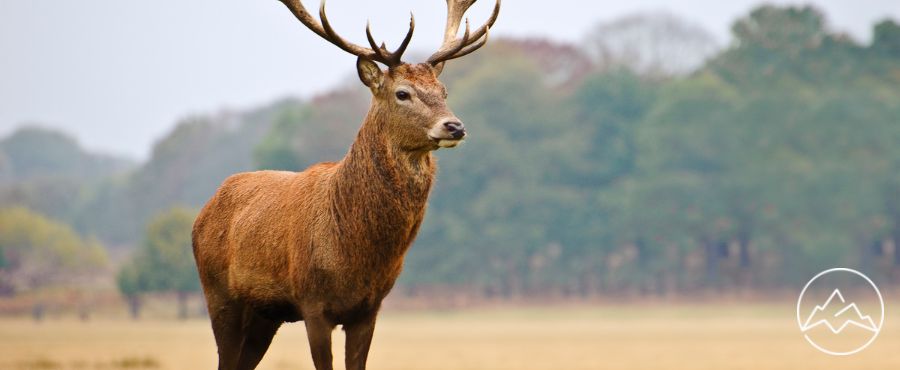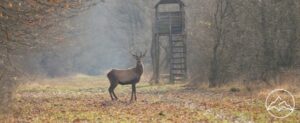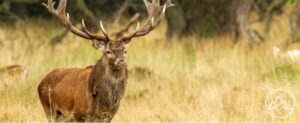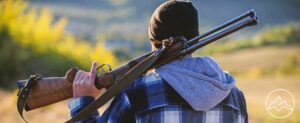Maintaining focus on your target is crucial, and with a paper or 3D target, there is a pre-marked reference for you to hit. With a live animal, things are different, and you must know the anatomy of a deer. You’ll need to pick your spot confidently and focus on it consistently from the point of the full draw until you fire your arrow. Deer hunting is easier if you have the right shot angle and aiming point.
Different deer shots
We’ll break down America’s most popular big-game animal – the whitetail deer. We’ll go through shot placement, recommended shots, and a few shots that aren’t recommended. While I’m talking about deer anatomy, these tips may also apply to other species such as mule deer, moose, and elk.
Broadside
You’ve likely heard about broadside shots if you’ve ever taken an introductory hunter education course. A broadside deer shot is a classic beginner shot; a well-placed arrow is going to be fatal almost every time. A deer standing broadside exposes all vitals (heart, lungs, liver), presenting them as an easy target. It’s not unheard of to get a double lung shot; it’s one of the best shots you can get. In addition, the only thing between your arrow and the deer’s vitals is the hide, a thin layer of ribs and muscle. The ribs aren’t very thick, and almost any broadhead arrow is capable of penetrating the chest cavity. Most modern bows have sufficient energy to allow the arrow to pass through the animal thoroughly. This allows for maximum damage, a cleaner kill, and an exit wound that will leave an impressive blood trail.
If you’re taking a broadside shot, it’s good to aim around five inches behind the shoulders and about halfway up the deer’s body. Many bowhunters aim directly for the heart, but this isn’t always ideal – you could hit the shoulder joint and fail to penetrate properly, resulting in a messy kill. Aiming higher is more forgiving. You’ll hit the lungs if you hit your target; if your arrow drifts closer to the shoulder, it’ll penetrate the heart and lungs. If it drifts back a little, you will hit the liver. If your arrow stays within a few inches of the target, the deer will be fatally wounded and won’t survive for long.
One possible issue is the position of the deer’s legs; you should wait until the leg closest to you is moving forward, taking the shoulder blade out of the way. The shoulder blade could obscure your shot if the deer’s front leg is improperly positioned.
Quartering away
The quartering-away shot is less common but deserves more attention. A well-executed quartering away shot is physically devastating, resulting in a fast takedown. It’s another forgiving angle; even if your aim is a bit off, your arrow will travel through the deer’s body up into the chest, where it’ll take out a combination of the lung, heart, or liver.
If you’re aiming for a quartering-away shot, you’ll use the opposite leg as a horizontal aiming guide, centering your shot halfway up the deer’s body (vertically). Even as the quartering angle increases, the quartering-away shot remains highly effective.
Keep in mind that as the deer moves away and enters a straightaway angle, your arrow will enter the deer from further behind on the near side while you aim at the opposite leg. One potential drawback of this position is that the arrow may become lodged in the opposite shoulder or buried in the chest cavity, which reduces the chances of an exit wound. This reduces external bleeding and makes it harder to track the deer. The benefit is that it’s unlikely the deer will go far.
Quartering to
It may be tempting to try a quartering-to shot, but you should avoid it, especially at close range. A deer quartering toward a hunter lets the near-side shoulder act as a shield for the vitals. Your arrow will be prevented from entering the chest cavity or deflecting it into a non-vital area of the body. Ribs also protect the vitals at this angle by causing deflections. If the arrow deflects, then the arrow is forced to slide between the outside of the ribcage and the hide, missing the chest cavity completely.
You might hit low in the brisket, but this shot is typically non-lethal. You’ll probably hit the sternum when aiming further forward, which prevents proper penetration. Further back, you’ll have a remote chance of hitting the lungs/liver, but this is unlikely. It’s more likely that you’ll get a gutshot. While a gutshot can take a deer down, this isn’t ethical nor easy to pull off[ as a deer can travel for hours or even days with a gutshot. For these reasons, you should avoid this shot.
Straightaway
A straightaway shot is possible for rifle hunters, who may refer to this angle as the ‘Texas heart shot.’ But there’s a big difference between a broadhead-tipped arrow and a bullet. The bullet can enter the back of the animal and pass through the cavity into the chest. There are thick leg bones and hip bones placed here; your arrow is unlikely to cut it. You’re more likely to make a gutshot. Tracking a deer with a gutshot is complex, and it usually results in a painful and unethical death for the deer. This angle is even harder to get right if you’re shooting from an elevated stand. For this reason, I don’t recommend straight-away shots.
Head-on
While head-on shots are great for rifle hunters, it’s not something I recommend bowhunters try. Though you can kill a deer with a head-on shot, it’s not always a great idea.
The animal expires within seconds if you aim for the neck and take out the jugular. If your aim is good enough (or you get lucky), you’ll find the soft spot between the spine and sternum and penetrate the chest cavity, taking out some vital organs. However, it’s a relatively small target. Finding it when shooting from an elevated spot is even more challenging. A head-on shot with a bow isn’t an ethical way to shoot and is more likely a way to lose your deer. It would be best if you waited for a better chance.Want to learn more about deer hunting? Check out our top 25 tips for hunting deer
Wrapping up
If you’re looking at getting into archery ahead of deer season, you should think of how to get the better shots. Head-on shots may provide the occasional quick kill but usually results in a wounded deer. It would be best if you considered a broadside or quartering shot to get a lethal shot, allowing you to hit the vitals and take down the deer ethically and quickly.











